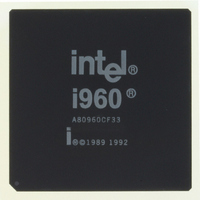A80960CF33 Intel, A80960CF33 Datasheet - Page 15

A80960CF33
Manufacturer Part Number
A80960CF33
Description
IC MPU I960CF 33MHZ 168-PGA
Manufacturer
Intel
Datasheet
1.A80960CF33.pdf
(70 pages)
Specifications of A80960CF33
Processor Type
i960
Features
CF suffix, 32-Bit with DMA, 4K Cache
Speed
33MHz
Voltage
5V
Mounting Type
Surface Mount
Package / Case
168-PGA
Family Name
80960
Device Core Size
32b
Frequency (max)
33MHz
Instruction Set Architecture
RISC
Supply Voltage 1 (typ)
5V
Operating Supply Voltage (max)
5.5V
Operating Supply Voltage (min)
4.5V
Operating Temp Range
0C to 100C
Operating Temperature Classification
Commercial
Mounting
Through Hole
Pin Count
168
Package Type
CPGA
Lead Free Status / RoHS Status
Lead free / RoHS Compliant
Other names
803084
Available stocks
Company
Part Number
Manufacturer
Quantity
Price
Datasheet
Table 4. 80960CF Pin Description—Processor Control Signals (Sheet 2 of 2)
Table 5. 80960CF Pin Description—DMA and Interrupt Unit Control Signals
EOP/TC3:0
PCLK2:1
DREQ3:0
DACK3:0
XINT7:0
V
Name
Name
CCPLL
V
V
NMI
NC
CC
SS
Type
H(Q)
R(Q)
H(Z/Q)
A(E/L)
Type
H(Z)
R(Z)
H(1)
R(1)
R(Z)
H(Z)
R(Z)
A(E)
H(Z)
R(Z)
A(L)
A(L)
O
S
–
–
–
–
I/O
O
S
I
I
I
PROCESSOR OUTPUT CLOCKS provide a timing reference for all inputs and
outputs. All input and output timings are specified in relation to PCLK2 and PCLK1.
PCLK2 and PCLK1 are identical signals. Two output pins are provided to allow
flexibility in the system’s allocation of capacitive loading on the clock. PCLK2:1 may
also be connected at the processor to form a single clock signal.
GROUND connections must be connected externally to a V
POWER connections must be connected externally to a V
V
Connecting a simple lowpass filter to V
noisy environments. Otherwise, V
NO CONNECT pins must not be connected in a system.
CCPLL
DMA REQUEST is used to request a DMA transfer. Each of the four signals
requests a transfer on a single channel. DREQ0 requests channel 0, DREQ1
requests channel 1, etc. When two or more channels are requested simultaneously,
the channel with the highest priority is serviced first. Channel priority mode is
programmable.
DMA ACKNOWLEDGE indicates that a DMA transfer is being executed. Each of
the four signals acknowledges a transfer for a single channel. DACK0
acknowledges channel 0, DACK1 acknowledges channel 1, etc. DACK3:0 are
asserted when the requesting device of a DMA is accessed.
END OF PROCESS/TERMINAL COUNT may be programmed as either an input
(EOP3:0) or output (TC3:0), but not both. Each pin is individually programmable.
When programmed as an input, EOPx causes termination of a current DMA transfer
for the channel that corresponds to the EOPx pin. EOP0 corresponds to channel 0,
EOP1 corresponds to channel 1, etc. When a channel is configured for source and
destination chaining, the EOP pin for that channel causes termination of only the
current buffer transferred and causes the next buffer to be transferred. EOP3:0 are
asynchronous inputs.
When programmed as an output, the channel’s TCx pin indicates that the channel
byte count has reached 0 and a DMA has terminated. TCx is driven with the same
timing as DACKx during the last DMA transfer for a buffer. When the last bus
request is executed as multiple bus accesses, TCx stays asserted for the entire bus
request.
EXTERNAL INTERRUPT PINS cause interrupts to be requested. These pins may
be configured in three modes:
Dedicated Mode: Each pin is a dedicated external interrupt source. Dedicated
inputs may be individually programmed to be level (low) or edge (falling) activated.
Expanded Mode: The eight pins act together as an 8-bit vectored interrupt source.
The interrupt pins in this mode are level activated. Since the interrupt pins are active
low, the vector number requested is the 1’s complement of the positive logic value
place on the port. This eliminates glue logic to interface to combinational priority
encoders which output negative logic.
Mixed Mode: XINT7:5 are dedicated sources and XINT4:0 act as the five most
significant bits of an expanded mode vector. The least significant bits are set to 010
internally.
NON-MASKABLE INTERRUPT causes a non-maskable interrupt event to occur.
NMI is the highest priority interrupt recognized. NMI is an edge (falling) activated
source.
is a separate V
CC
supply pin for the phase lock loop used in 1-x clock mode.
CCPLL
Description
Description
CCPLL
should be connected to V
may help reduce clock jitter (T
CC
SS
board plane.
board plane.
80960-40, -33, -25
CC
.
CP
) in
15













